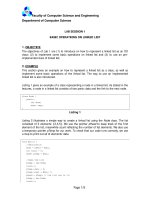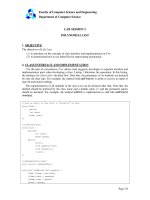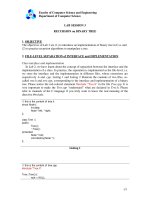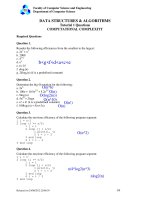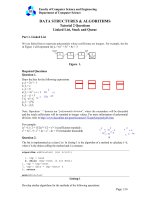fundamentals of materials science and engineering ( PDFDrive )
Bạn đang xem bản rút gọn của tài liệu. Xem và tải ngay bản đầy đủ của tài liệu tại đây (26.23 MB, 911 trang )
P1: PBU/OVY
P2: PBU/OVY
GTBL042-Calister-FM
QC: PBU/OVY
T1: PBU
Printer: tb-gts4c
GTBL042-Callister-v3
October 12, 2007
xxvi
Revise Pages
12:19
P1: PBU/OVY
P2: PBU/OVY
GTBL042-Calister-FM
QC: PBU/OVY
T1: PBU
Printer: tb-gts4c
GTBL042-Callister-v3
October 15, 2007
i
Revise Pages
18:52
P1: PBU/OVY
P2: PBU/OVY
GTBL042-Calister-FM
QC: PBU/OVY
T1: PBU
Printer: tb-gts4c
GTBL042-Callister-v3
October 15, 2007
ii
Revise Pages
18:52
P1: PBU/OVY
P2: PBU/OVY
GTBL042-Calister-FM
QC: PBU/OVY
T1: PBU
Printer: tb-gts4c
GTBL042-Callister-v3
October 12, 2007
Fundamentals of Materials
Science and Engineering
An Integrated Approach
iii
Revise Pages
21:10
P1: PBU/OVY
P2: PBU/OVY
GTBL042-Calister-FM
QC: PBU/OVY
T1: PBU
Printer: tb-gts4c
GTBL042-Callister-v3
October 12, 2007
THIRD EDITION
Fundamentals of Materials
Science and Engineering
An Integrated Approach
William D. Callister, Jr.
Department of Metallurgical Engineering
The University of Utah
David G. Rethwisch
Department of Chemical and Biochemical Engineering
The University of Iowa
JOHN WILEY & SONS, INC.
v
Revise Pages
21:10
P1: PBU/OVY
P2: PBU/OVY
GTBL042-Calister-FM
QC: PBU/OVY
T1: PBU
Printer: tb-gts4c
GTBL042-Callister-v3
October 18, 2007
Front Cover: Depiction of a boron nitride nanotube. Red and blue spheres represent boron and nitrogen
atoms, respectively.
Back Cover: Representation of a carbon nanotube, both ends of which are capped with C60 fullerene
hemispheres.
Associate Publisher
Acquisitions Editor
Editorial Assistant
Marketing Manager
Senior Production Editor
Senior Designer
Cover Art
Senior Illustration Editor
Media Editor
Dan Sayre
Jennifer Welter
Sandra Kim
Chris Ruel
Ken Santor
Kevin Murphy
Roy Wiemann
Sigmund Malinowski
Lauren Sapira
This book was set in LaTeX by Aptara, Inc. and printed and bound by Quebecor Versailles. The cover
was printed by Quebecor.
This book is printed on acid free paper. ∞
Copyright © 2008 John Wiley & Sons, Inc. All rights reserved.
No part of this publication may be reproduced, stored in a retrieval system or transmitted in any form or
by any means, electronic, mechanical, photocopying, recording, scanning or otherwise, except as
permitted under Sections 107 or 108 of the 1976 United States Copyright Act, without either the prior
written permission of the Publisher, or authorization through payment of the appropriate per-copy
fee to the Copyright Clearance Center, 222 Rosewood Drive, Danvers, MA 01923, (508)750-8400,
fax (508)750-4470, Web site www.copyright.com. Requests to the Publisher for permission should be
addressed to the Permissions Department, John Wiley & Sons, Inc., 111 River Street, Hoboken NJ
07030-5774, (2012) 748-6011, fax (201) 748-6008, E-Mail: , Web site
www.wiley.com/go/permissions.
To order books or for customer service please call 1(800)-CALL WILEY (225-5945).
Library of Congress Cataloging-in-Publication Data
Callister, William D., 1940–
Fundamentals of materials science and engineering : an integrated approach /
William D. Callister ; with special contributions by David G. Rethwisch.—3rd ed.
p. cm.
Includes index.
ISBN 978-0-470-12537-3 (cloth)
1. Materials. I. Rethwisch, David G. II. Title.
TA403.C227 2008
620.1 1—dc22
2007040687
Printed in the United States
10 9 8 7 6 5 4 3 2 1
vi
Revise Pages
1:1
P1: PBU/OVY
P2: PBU/OVY
GTBL042-Calister-FM
QC: PBU/OVY
T1: PBU
Printer: tb-gts4c
GTBL042-Callister-v3
October 12, 2007
Dedicated to
the memory of Genevieve Johns Callister, 1913–2007
vii
Revise Pages
12:19
P1: PBU/OVY
P2: PBU/OVY
GTBL042-Calister-FM
QC: PBU/OVY
T1: PBU
Printer: tb-gts4c
GTBL042-Callister-v3
October 12, 2007
iv
Revise Pages
12:19
P1: PBU/OVY
P2: PBU/OVY
GTBL042-Calister-FM
QC: PBU/OVY
T1: PBU
Printer: tb-gts4c
GTBL042-Callister-v3
October 12, 2007
viii
Revise Pages
12:19
P1: PBU/OVY
P2: PBU/OVY
GTBL042-Calister-FM
QC: PBU/OVY
GTBL042-Callister-v3
T1: PBU
Printer: tb-gts4c
October 12, 2007
Preface
Imaterials
n this Third Edition we have retained the objectives and approaches for teaching
science and engineering that were presented in previous editions. The first,
and primary, objective is to present the basic fundamentals on a level appropriate for
university/college students who have completed their freshmen calculus, chemistry,
and physics courses. In order to achieve this goal, we have endeavored to use terminology that is familiar to the student who is encountering the discipline of materials
science and engineering for the first time, and also to define and explain all unfamiliar
terms.
The second objective is to present the subject matter in a logical order, from the
simple to the more complex. Each chapter builds on the content of previous ones.
The third objective, or philosophy, that we strive to maintain throughout the text
is that if a topic or concept is worth treating, then it is worth treating in sufficient
detail and to the extent that students have the opportunity to fully understand it
without having to consult other sources; also, in most cases, some practical relevance is
provided. Discussions are intended to be clear and concise and to begin at appropriate
levels of understanding.
The fourth objective is to include features in the book that will expedite the
learning process. These learning aids include:
• Numerous illustrations, now presented in full color, and photographs to help
visualize what is being presented;
• Learning objectives, to focus student attention on what they should be getting
from each chapter;
• “Why Study . . .” and “Materials of Importance” items that provide relevance to
topic discussions;
• Key terms, and descriptions of key equations, highlighted in the margins for
quick reference;
• End-of-chapter questions and problems designed to progressively develop students’ understanding of concepts and facility with skills;
• Answers to selected problems, so that students can check their work;
• A glossary, list of symbols, and references to facilitate understanding the subject
matter.
The fifth objective is to enhance the teaching and learning process by using the
newer technologies that are available to most instructors and students of engineering
today.
• ix
Revise Pages
12:19
P1: PBU/OVY
P2: PBU/OVY
GTBL042-Calister-FM
QC: PBU/OVY
T1: PBU
Printer: tb-gts4c
GTBL042-Callister-v3
October 12, 2007
x • Preface
ORGANIZATION OF THE TEXT
There are two common approaches for materials science and engineering—one that
we call the “traditional” approach, and the other which most refer to as the “integrated” approach. With the integrated approach, one particular structure, characteristic, or property for all three material types is presented before moving on to the
discussion of another structure/characteristic/property. This is the order of presentation in this book, Fundamentals of Materials Science and Engineering, Third Edition,
which is depicted by the following schematic diagram:
Structures
Metals
Ceramics
Polymers
Defects
Metals
Ceramics
Polymers
Diffusion
Metals
Ceramics
Polymers
Mechanical
Properties
Metals
Ceramics
Polymers
Some instructors prefer this organizational approach for the following reasons:
(1) students come to realize and appreciate differences in the characteristics and
properties of the various material types; and (2) when considering properties and
processing, all material types should be included.
With the traditional approach, structures/characteristics/properties of metals are
presented first, followed by analogous discussions for ceramic materials and polymers. Our other book, Materials Science and Engineering: An Introduction, Seventh
Edition is organized in this manner.
NEW TO THIS EDITION
New/Revised Content
Several important changes have been made with this Third Edition. One of the
most significant is the incorporation of a number of new sections, as well as revisions/amplifications of other sections. New sections/discussions are as follows:
•
•
•
•
One-Component (or Unary) Phase Diagrams (Section 10.6)
Compacted graphite iron (in Section 13.2, “Ferrous Alloys”)
Lost Foam Casting (in Section 14.3, “Casting”)
Temperature dependence of Frenkel and Schottky defects (in Section 5.3, “Point
Defects in Ceramics”)
• Crystallization of glass-ceramics, in terms of continuous cooling transformation
diagrams (in Section 13.5, “Glass-Ceramics”)
• Permeability in polymers (in Section 6.7, “Diffusion in Ionic and Polymeric Materials”)
Those sections that have been revised/amplified include the following:
• Treatments in Chapter 1 (“Introduction”) on the several material types have
been enlarged to include comparisons of various property values (as bar charts).
• Refined terminology and representations of polymer structures (Sections 4.3
through 4.8).
• Eliminated discussion on fringed-micelle model (found in Section 4.12 of the
second edition).
• Enhanced discussion on defects in polymers (Section 5.5).
Revise Pages
21:10
P1: PBU/OVY
P2: PBU/OVY
GTBL042-Calister-FM
QC: PBU/OVY
T1: PBU
GTBL042-Callister-v3
Printer: tb-gts4c
October 12, 2007
Preface • xi
• Comparisons of (1) dimensional size ranges for various structural elements, and
(2) resolution ranges for the several microscopic examination techniques (in
Section 5.12, “Microscopic Techniques”).
• Updates on hardness testing techniques (Section 7.16).
• Revised discussion on the Burgers vector (Section 8.5).
• New discussion on why recrystallization temperature depends on the purity of a
metal (Section 8.13).
• Revised discussion on deformation of semicrystalline polymers (Section 8.17)
• Transferred some of the details on fracture mechanics (Section 9.5) to an online
module (Web Module M).
• Expanded discussion on nondestructive testing (Section 9.5).
• Transferred some of the discussion on crack initiation and propagation (for fatigue, Section 9.12), and the section on crack propagation rate (Section 9.13 of
the second edition) to an online module (Web Module M).
• Expanded discussion of polymer adhesives (in Section 13.15).
• Updated the discussion on the process for making sheet glass (in Section 14.7).
• Revised discussions on polymerization (Section 14.11) and the fabrication of
fibers and films (Section 14.15).
• Revised treatment of polymer degradation (Section 16.12).
Materials of Importance
In “Materials of Importance” sections we discuss familiar and interesting materials/
applications of materials. These pieces lend some relevance to topical coverage, are
found in most chapters in the book, and include the following:
•
•
•
•
•
•
•
•
•
•
•
•
•
•
•
•
•
Carbonated Beverage Containers
Water (Its Volume Expansion Upon Freezing)
Tin (Its Allotropic Transformation)
Catalysts (and Surface Defects)
Aluminum for Integrated Circuit Interconnects
Lead-Free Solders
Shape-Memory Alloys
Metal Alloys Used for Euro Coins
Carbon Nanotubes
Piezoelectric Ceramics
Shrink-Wrap Polymer Films
Phenolic Billiard Balls
Nanocomposites in Tennis Balls
Aluminum Electrical Wires
Invar and Other Low-Expansion Alloys
An Iron-Silicon Alloy That is Used in Transformer Cores
Light-Emitting Diodes
Discipline-Specific Modules
A set of discipline-specific modules appear on the book’s Web site. These modules
treat materials science/engineering topics, not covered in the print text, that are
Revise Pages
12:19
P1: PBU/OVY
P2: PBU/OVY
GTBL042-Calister-FM
QC: PBU/OVY
T1: PBU
Printer: tb-gts4c
GTBL042-Callister-v3
October 12, 2007
xii • Preface
relevant to each of the four major engineering disciplines—mechanical, civil, chemical, and electrical—and, in addition, biomaterials. Furthermore, most of the case
studies found in the “Materials Selection and Design Considerations” chapter of the
second edition appear in at least one of these modules.
Format Changes
There are several other major changes from the format of the second edition. First
of all, no CD-ROM is packaged with the in-print text; all electronic components are
found on the book’s Web site (www.wiley.com/college/callister). Also, whereas five
chapters of the second edition were in electronic format only (i.e., not in print), in
this third edition, all chapters are in print. In addition, approximately half of the endof-chapter problems and questions have been removed from the print book, and are
posted on both Student and Instructor Companion Sites. This has allowed us to keep
the book to a reasonable length, while still making all of the problems and questions
available to both students and instructors for use in assignments.
STUDENT LEARNING RESOURCES
(www.wiley.com/college/callister)
Also found on the book’s Web site (under “Student Companion Site”) are several
important instructional elements for the student that complement the text; these
include the following:
1. VMSE: Virtual Materials Science and Engineering. This is an expanded version of the software program that accompanied the previous edition. It consists of
interactive simulations and animations that enhance the learning of key concepts
in materials science and engineering, and, in addition, a materials properties/cost
database. Students can access VMSE via the registration code included on the inside
front cover of the textbook.
Throughout the book, whenever there is some text or a problem that is supplemented by VMSE, a small “icon” that denotes the associated module is included in
one of the margins. These modules and their corresponding icons are as follows:
Metallic Crystal Structures
and Crystallography
Phase Diagrams
Ceramic Crystal Structures
Diffusion
Repeat Unit and Polymer
Structures
Tensile Tests
Dislocations
Solid-Solution Strengthening
2. Answers to the Concept Check questions. Students can visit the Web site to find
the correct answers to the Concept Check questions.
3. Direct access to online self-assessment exercises. This is a Web-based assessment
program that contains questions and problems similar to those found in the text;
these problems/questions are organized and labeled according to textbook sections.
An answer/solution that is entered by the user in response to a question/problem is
graded immediately, and comments are offered for incorrect responses. The student
Revise Pages
12:19
P1: PBU/OVY
P2: PBU/OVY
GTBL042-Calister-FM
QC: PBU/OVY
T1: PBU
GTBL042-Callister-v3
Printer: tb-gts4c
October 12, 2007
Preface • xiii
may use this electronic resource to review course material, and to assess his/her
mastery and understanding of topics covered in the text.
4. Index of Learning Styles. Upon answering a 44-item questionnaire, a user’s
learning style preference (i.e., the manner in which information is assimilated and
processed) is assessed.
5. Extended Learning Objectives—a more extensive list of learning objectives
than is provided at the beginning of each chapter. These direct the student to study
the subject material to a greater degree of depth.
6. Links to Other Web Resources. These links are categorized according to general internet, software, teaching, specific course content/activities, and materials
databases.
INSTRUCTORS’ RESOURCES
The “Instructor Companion Site” (www.wiley.com/college/callister) is available for
instructors who have adopted this text. Please visit the Web site to register for access.
Resources that are available include the following:
1. Instructor Solutions Manual. Detailed solutions of all end-of-chapter questions
and problems (in both Word r and Adobe Acrobat r PDF formats).
2 Photographs, illustrations, and tables that appear in the book. These are in both
PDF and JPEG formats so that instructors can print them for handouts or prepare
transparencies in their desired format.
3. A set of PowerPoint r lecture slides. These slides, developed by Peter M. Anderson (The Ohio State University), follow the flow of topics in the text, and include
materials from the text and other sources as well as illustrations and animations.
Instructors may use the slides as is or edit them to fit their teaching needs.
4. A list of classroom demonstrations and laboratory experiments. These portray
phenomena and/or illustrate principles that are discussed in the book; references are
also provided that give more detailed accounts of these demonstrations.
5. Conversion guide. This guide notes, for each homework problem/question (by
number), whether or not it appeared in the second edition of Fundamentals, and,
if so, its number in this previous edition. Some problems have been refreshed (i.e.,
new numbers were assigned to values of parameters given the problem statement);
refreshed problems are also indicated in this conversion guide.
6. Suggested course syllabi for the various engineering disciplines. Instructors may
consult these syllabi for guidance in course/lecture organization and planning.
WileyPLUS
WileyPLUS gives you, the instructor, the technology to create an environment where
students reach their full potential and experience academic success that will last a
lifetime! With WileyPLUS, students will come to class better prepared for your lectures, get immediate feedback and context-sensitive help on assignments and quizzes,
and have access to a full range of interactive learning resources including a complete
online version of their text. WileyPLUS gives you a wealth of presentation and preparation tools, easy-to-navigate assessment tools including an online gradebook, and a
complete system to administer and manage your course exactly as you wish. Contact
your local Wiley representative for details on how to set up your WileyPLUS course,
or visit the Web site at www.wileyplus.com.
FEEDBACK
We have a sincere interest in meeting the needs of educators and students in the
materials science and engineering community, and, therefore, would like to solicit
Revise Pages
12:19
P1: PBU/OVY
P2: PBU/OVY
GTBL042-Calister-FM
QC: PBU/OVY
GTBL042-Callister-v3
T1: PBU
Printer: tb-gts4c
October 12, 2007
xiv • Preface
feedback on this third edition. Comments, suggestions, and criticisms may be submitted to the authors via e-mail at the following address:
ACKNOWLEDGMENTS
Appreciation is expressed to those who have made contributions to this edition. We
sincerely appreciate Grant E. Head’s expert programming skills, which he used in developing the Virtual Materials Science and Engineering software. Important input was
also furnished by Carl Wood of Utah State University, W. Roger Cannon of Rutgers
University (retired), Katherine C. Chen of California Polytechnic State University
(San Luis Obispo), Guna Selvaduray of San Jose State University, Ralf Burgel
ă
of the
Swiss Federal Laboratories for Materials Testing and Research, and Audrey A. Butler
of the University of Iowa to whom we also give thanks. In addition, helpful ideas
and suggestions have been provided by the following: Pranesh B. Aswath, University
of Texas at Arlington; Russell J. Composto, University of Pennsylvania; Lisa Friis,
University of Kansas; Joseph I. Goldstein, University of Massachusetts Amherst;
Richard Griffin, Texas A & M University; Jaime C. Grunlan, Texas A & M University; Carol Handwerker, Purdue University; Maureen M. Julian, Virginia Tech;
Angela L. Moran, United States Naval Academy; Steven Nutt, University of Southern California; David C. Paine, Brown University; Ken Sampson, Ohio University;
Thomas W. Staley, Virginia Tech.
We are also indebted to Jenny Welter and Joseph P. Hayton, Sponsoring Editors,
and to Kenneth Santor, Senior Production Editor at Wiley for their assistance and
guidance on this revision.
Since undertaking the task of writing this and previous editions, instructors and
students, too numerous to mention, have shared their input and contributions on
how to make this work more effective as a teaching and learning tool. To all those
who have helped, we express our sincere Thanks!
Last, but certainly not least, the continual encouragement and support of our
families and friends is deeply and sincerely appreciated.
William D. Callister, Jr.
David G. Rethwisch
Revise Pages
12:19
P1: PBU/OVY
P2: PBU/OVY
GTBL042-Calister-FM
QC: PBU/OVY
T1: PBU
Printer: tb-gts4c
GTBL042-Callister-v3
October 12, 2007
Contents
LIST OF SYMBOLS
xxiii
1 Introduction
1.1
1.2
1.3
1.4
1.5
1.6
1
Learning Objectives 2
Historical Perspective 2
Materials Science and Engineering 3
Why Study Materials Science and Engineering?
Classification of Materials 5
Advanced Materials 10
Modern Materials Needs 13
5
References 14
Questions 14
2 Atomic Structure and Interatomic Bonding
2.1
Learning Objectives
Introduction 16
15
16
ATOMIC STRUCTURE 16
2.2
2.3
2.4
Fundamental Concepts 16
Electrons in Atoms 17
The Periodic Table 23
ATOMIC BONDING IN SOLIDS
2.5
2.6
2.7
2.8
24
Bonding Forces and Energies 24
Primary Interatomic Bonds 27
Secondary Bonding or van der Waals Bonding
Molecules 34
Summary 34
Important Terms and Concepts
References 35
Questions and Problems 35
35
3 Structures of Metals and Ceramics
3.1
3.2
31
37
Learning Objectives 38
Introduction 38
Fundamental Concepts 38
• xv
Revise Pages
12:19
P1: PBU/OVY
P2: PBU/OVY
GTBL042-Calister-FM
QC: PBU/OVY
T1: PBU
Printer: tb-gts4c
GTBL042-Callister-v3
October 12, 2007
xvi • Contents
CRYSTAL STRUCTURES 38
3.3
3.4
3.5
3.6
3.7
3.8
3.9
3.10
3.11
Unit Cells 39
Metallic Crystal Structures 40
Density Computations—
Metals 44
Ceramic Crystal Structures 45
Density Computations—
Ceramics 52
Silicate Ceramics 54
Carbon 58
Polymorphism and
Allotropy 61
Crystal Systems 61
CRYSTALLOGRAPHIC POINTS,
DIRECTIONS, AND PLANES 64
3.12
3.13
3.14
3.15
3.16
Point Coordinates 64
Crystallographic Directions 66
Crystallographic Planes 70
Linear and Planar Densities 75
Close-Packed Crystal
Structures 77
CRYSTALLINE AND NONCRYSTALLINE
MATERIALS 80
3.17
3.18
3.19
3.20
3.21
4 Polymer Structures
4.1
4.2
4.3
4.4
4.5
4.6
4.7
4.8
4.9
4.10
Polymer Crystallinity 117
Polymer Crystals 121
Summary 123
Important Terms and Concepts
References 124
Questions and Problems 125
5 Imperfections in Solids
5.1
Learning Objectives
Introduction 128
124
127
128
POINT DEFECTS 128
5.2
5.3
5.4
5.5
5.6
Point Defects in Metals 128
Point Defects in Ceramics 130
Impurities in Solids 133
Point Defects in Polymers 136
Specification of
Composition 136
5.7
Dislocations—Linear
Defects 140
Interfacial Defects 144
Bulk or Volume Defects 147
Atomic Vibrations 147
MISCELLANEOUS IMPERFECTIONS
5.8
5.9
5.10
Single Crystals 80
Polycrystalline Materials 80
Anisotropy 82
X-Ray Diffraction:
Determination of Crystal
Structures 83
Noncrystalline Solids 87
Summary 89
Important Terms and Concepts
References 92
Questions and Problems 92
4.11
4.12
140
MICROSCOPIC EXAMINATION 149
5.11
5.12
5.13
Summary 156
Important Terms and Concepts
References 158
Questions and Problems 158
91
97
Learning Objectives 98
Introduction 98
Hydrocarbon Molecules 98
Polymer Molecules 100
The Chemistry of Polymer
Molecules 101
Molecular Weight 106
Molecular Shape 108
Molecular Structure 109
Molecular Configurations 111
Thermoplastic and
Thermosetting Polymers 115
Copolymers 116
General 149
Microscopic Techniques 150
Grain Size Determination 155
6 Diffusion
6.1
6.2
6.3
6.4
6.5
6.6
6.7
158
161
Learning Objectives 162
Introduction 162
Diffusion Mechanisms 163
Steady-State Diffusion 165
Nonsteady-State Diffusion 167
Factors That Influence
Diffusion 171
Other Diffusion Paths 177
Diffusion in Ionic and Polymeric
Materials 177
Summary 181
Important Terms and Concepts
References 182
Questions and Problems 182
Revise Pages
182
12:19
P1: PBU/OVY
P2: PBU/OVY
GTBL042-Calister-FM
QC: PBU/OVY
T1: PBU
Printer: tb-gts4c
GTBL042-Callister-v3
October 12, 2007
Contents • xvii
7 Mechanical Properties
7.1
7.2
186
Learning Objectives 187
Introduction 187
Concepts of Stress and
Strain 188
8 Deformation and
Strengthening
Mechanisms 242
8.1
Stress–Strain Behavior
Anelasticity 196
Elastic Properties
of Materials 196
192
MECHANICAL BEHAVIOR—METALS 199
7.6
7.7
7.8
7.9
Tensile Properties 200
True Stress and Strain 207
Elastic Recovery After Plastic
Deformation 210
Compressive, Shear, and
Torsional Deformation 211
MECHANICAL BEHAVIOR—
CERAMICS 211
7.10
7.11
7.12
MECHANICAL BEHAVIOR—
POLYMERS 214
7.13
7.14
7.15
Stress–Strain Behavior 215
Macroscopic Deformation 217
Viscoelastic Deformation 218
HARDNESS AND OTHER
MECHANICAL PROPERTY
CONSIDERATIONS 222
7.16
7.17
7.18
7.19
7.20
8.2
8.3
8.4
8.5
8.6
8.7
8.8
Hardness 222
Hardness of Ceramic
Materials 228
Tear Strength and Hardness
of Polymers 228
8.10
8.11
8.12
8.13
8.14
Recovery 264
Recrystallization 264
Grain Growth 269
DEFORMATION MECHANISMS FOR
CERAMIC MATERIALS 270
8.15
8.16
Crystalline Ceramics 271
Noncrystalline Ceramics 271
MECHANISMS OF DEFORMATION
AND FOR STRENGTHENING OF
POLYMERS 272
8.17
8.18
Variability of Material
Properties 229
Design/Safety Factors 232
8.19
236
Strengthening by Grain Size
Reduction 257
Solid-Solution
Strengthening 259
Strain Hardening 260
RECOVERY, RECRYSTALLIZATION, AND
GRAIN GROWTH 263
PROPERTY VARIABILITY AND
DESIGN/SAFETY FACTORS 229
Summary 233
Important Terms
and Concepts 235
References 235
Questions and Problems
Historical 244
Basic Concepts of
Dislocations 244
Characteristics of
Dislocations 246
Slip Systems 248
Slip in Single Crystals 250
Plastic Deformation of
Polycrystalline Metals 253
Deformation by Twinning 255
MECHANISMS OF STRENGTHENING IN
METALS 256
8.9
Flexural Strength 211
Elastic Behavior 213
Influence of Porosity on the
Mechanical Properties of
Ceramics 213
243
DEFORMATION MECHANISMS FOR
METALS 243
ELASTIC DEFORMATION 192
7.3
7.4
7.5
Learning Objectives
Introduction 243
Deformation of Semicrystalline
Polymers 272
Factors That Influence the
Mechanical Properties of
Semicrystalline Polymers 274
Deformation of
Elastomers 278
Summary 281
Important Terms and
Concepts 283
References 283
Questions and Problems
284
Revise Pages
12:19
P1: PBU/OVY
P2: PBU/OVY
GTBL042-Calister-FM
QC: PBU/OVY
T1: PBU
Printer: tb-gts4c
GTBL042-Callister-v3
October 12, 2007
xviii • Contents
9 Failure
9.1
10.4
10.5
10.6
288
Learning Objectives
Introduction 289
289
FRACTURE 289
9.2
9.3
9.4
9.5
9.6
9.7
9.8
BINARY PHASE DIAGRAMS
Fundamentals of Fracture 289
Ductile Fracture 290
Brittle Fracture 293
Principles of Fracture
Mechanics 293
Brittle Fracture of
Ceramics 304
Fracture of Polymers 308
Impact Fracture
Testing 309
10.7
10.8
10.9
10.10
10.11
10.12
FATIGUE 314
9.9
9.10
9.11
9.12
9.13
9.14
10.13
Cyclic Stresses 315
The S–N Curve 317
Fatigue in Polymeric
Materials 319
Crack Initiation and
Propagation 320
Factors that Affect Fatigue
Life 322
Environmental Effects 325
10.14
10.15
10.16
10.17
10.18
CREEP 326
9.15
9.16
9.17
9.18
9.19
Generalized Creep
Behavior 326
Stress and Temperature
Effects 328
Data Extrapolation
Methods 329
Alloys for High-Temperature
Use 331
Creep in Ceramic and Polymeric
Materials 331
Summary 332
Important Terms and Concepts
References 334
Questions and Problems 335
10 Phase Diagrams
10.1
339
Learning Objectives
Introduction 340
DEFINITIONS AND BASIC
CONCEPTS 340
10.2
10.3
Solubility Limit
Phases 341
Microstructure 342
Phase Equilibria 342
One-Component (or Unary)
Phase Diagrams 343
341
345
Binary Isomorphous
Systems 345
Interpretation of Phase
Diagrams 347
Development of Microstructure
in Isomorphous Alloys 351
Mechanical Properties of
Isomorphous Alloys 355
Binary Eutectic Systems 356
Development of Microstructure
in Eutectic Alloys 361
Equilibrium Diagrams Having
Intermediate Phases or
Compounds 369
Eutectoid and Peritectic
Reactions 371
Congruent Phase
Transformations 372
Ceramic Phase Diagrams 373
Ternary Phase Diagrams 378
The Gibbs Phase Rule 378
THE IRON–C ARBON SYSTEM 380
10.19
The Iron–Iron Carbide
(Fe–Fe3 C) Phase Diagram 380
10.20 Development of Microstructure
in Iron–Carbon Alloys 384
10.21 The Influence of Other Alloying
Elements 391
Summary 392
Important Terms and Concepts
References 394
Questions and Problems 394
394
334
11 Phase Transformations
11.1
Learning Objectives
Introduction 401
400
401
PHASE TRANSFORMATIONS
IN METALS 401
340
11.2
11.3
11.4
Basic Concepts 402
The Kinetics of Phase
Transformations 402
Metastable Versus Equilibrium
States 413
Revise Pages
12:19
P1: PBU/OVY
P2: PBU/OVY
GTBL042-Calister-FM
QC: PBU/OVY
T1: PBU
Printer: tb-gts4c
GTBL042-Callister-v3
October 12, 2007
Contents • xix
12.8
MICROSTRUCTURAL AND PROPERTY
CHANGES IN IRON–C ARBON
ALLOYS 414
11.5
11.6
11.7
11.8
11.9
Isothermal Transformation
Diagrams 414
Continuous Cooling
Transformation Diagrams 426
Mechanical Behavior of
Iron–Carbon Alloys 430
Tempered Martensite 434
Review of Phase
Transformations and Mechanical
Properties for Iron–Carbon
Alloys 437
12.9
SEMICONDUCTIVITY
12.10
12.11
12.12
12.13
12.14
12.15
Heat Treatments 441
Mechanism of Hardening
Miscellaneous
Considerations 446
443
11.17
Crystallization 447
Melting 448
The Glass Transition 448
Melting and Glass Transition
Temperatures 449
Factors That Influence Melting
and Glass Transition
Temperatures 450
Summary 452
Important Terms and Concepts
References 454
Questions and Problems 454
12 Electrical Properties
12.1
Learning Objectives
Introduction 461
12.5
12.6
12.7
Intrinsic Semiconduction 474
Extrinsic Semiconduction 477
The Temperature Dependence
of Carrier Concentration 481
Factors That Affect Carrier
Mobility 483
The Hall Effect 488
Semiconductor Devices 489
454
Conduction in Ionic
Materials 497
Electrical Properties of
Polymers 497
DIELECTRIC BEHAVIOR 498
12.18
12.19
12.20
12.21
12.22
12.23
Capacitance 498
Field Vectors and
Polarization 500
Types of Polarization 504
Frequency Dependence of the
Dielectric Constant 505
Dielectric Strength 506
Dielectric Materials 507
OTHER ELECTRICAL CHARACTERISTICS
OF MATERIALS 507
12.24
12.25
Ferroelectricity 507
Piezoelectricity 508
Summary 509
Important Terms and Concepts
References 511
Questions and Problems 512
460
461
ELECTRICAL CONDUCTION 461
12.2
12.3
12.4
12.16
12.17
CRYSTALLIZATION, MELTING, AND GLASS
TRANSITION PHENOMENA IN POLYMERS
447
11.13
11.14
11.15
11.16
474
ELECTRICAL CONDUCTION IN IONIC
CERAMICS AND IN POLYMERS 496
PRECIPITATION HARDENING 438
11.10
11.11
11.12
Electrical Resistivity of
Metals 469
Electrical Characteristics of
Commercial Alloys 471
Ohm’s Law 461
Electrical Conductivity 462
Electronic and Ionic
Conduction 463
Energy Band Structures in
Solids 463
Conduction in Terms of Band
and Atomic Bonding
Models 466
Electron Mobility 467
13 Types and Applications of
Materials 516
13.1
Learning Objectives
Introduction 517
517
13.2
13.3
Ferrous Alloys 517
Nonferrous Alloys 530
T YPES OF METAL ALLOYS 517
T YPES OF CERAMICS 540
13.4
13.5
Glasses 541
Glass–Ceramics
541
Revise Pages
511
12:19
P1: PBU/OVY
P2: PBU/OVY
GTBL042-Calister-FM
QC: PBU/OVY
T1: PBU
Printer: tb-gts4c
GTBL042-Callister-v3
October 12, 2007
xx • Contents
13.6
13.7
13.8
13.9
13.10
13.11
Clay Products 543
Refractories 543
Abrasives 545
Cements 546
Advanced Ceramics 547
Diamond and Graphite 550
Summary 612
Important Terms and Concepts
References 614
Questions and Problems 614
15 Composites
T YPES OF POLYMERS 552
13.12
13.13
13.14
13.15
13.16
Plastics 552
Elastomers 552
Fibers 557
Miscellaneous
Applications 557
Advanced Polymeric
Materials 559
15.1
Large–Particle Composites
Dispersion-Strengthened
Composites 624
15.4
15.5
Influence of Fiber Length 625
Influence of Fiber Orientation
and Concentration 626
The Fiber Phase 635
The Matrix Phase 637
Polymer-Matrix
Composites 637
Metal-Matrix Composites 644
Ceramic-Matrix
Composites 645
Carbon–Carbon
Composites 646
Hybrid Composites 647
Processing of Fiber-Reinforced
Composites 648
15.6
15.7
15.8
15.11
14.2
14.3
14.4
Forming Operations 569
Casting 571
Miscellaneous Techniques
14.5
14.6
Annealing Processes 575
Heat Treatment of Steels 577
573
15.12
15.13
THERMAL PROCESSING OF METALS 574
FABRICATION OF CERAMIC
MATERIALS 589
14.8
14.9
14.10
14.14
14.15
Polymerization 603
Polymer Additives 606
Forming Techniques for
Plastics 607
Fabrication of Elastomers
Fabrication of Fibers and
Films 610
620
STRUCTURAL COMPOSITES 650
15.14
15.15
Laminar Composites 651
Sandwich Panels 651
Summary 654
Important Terms and Concepts
References 656
Questions and Problems 656
Fabrication and Processing
of Glasses and Glass–
Ceramics 589
Fabrication and Processing
of Clay Products 594
Powder Pressing 600
Tape Casting 602
656
16 Corrosion and Degradation
of Materials 660
SYNTHESIS AND FABRICATION OF
POLYMERS 603
14.11
14.12
14.13
618
15.2
15.3
15.9
15.10
569
FABRICATION OF METALS 569
14.7
Learning Objectives
Introduction 618
FIBER-REINFORCED COMPOSITES 625
565
14 Synthesis, Fabrication, and
Processing of Materials 568
14.1
617
PARTICLE-REINFORCED
COMPOSITES 620
Summary 563
Important Terms and Concepts
References 565
Questions and Problems 566
Learning Objectives
Introduction 569
613
16.1
Learning Objectives
Introduction 661
661
CORROSION OF METALS 661
16.2
610
16.3
16.4
16.5
Electrochemical
Considerations 662
Corrosion Rates 670
Prediction of Corrosion
Rates 671
Passivity 678
Revise Pages
12:19
P1: PBU/OVY
P2: PBU/OVY
GTBL042-Calister-FM
QC: PBU/OVY
T1: PBU
Printer: tb-gts4c
GTBL042-Callister-v3
October 12, 2007
Contents • xxi
16.6
16.7
16.8
16.9
16.10
Environmental Effects 680
Forms of Corrosion 680
Corrosion Environments 688
Corrosion Prevention 689
Oxidation 691
CORROSION OF CERAMIC
MATERIALS 694
16.11
16.12
16.13
18.4
18.5
18.6
18.7
18.8
18.9
18.10
18.11
18.12
19.5
19.6
19.7
19.8
19.9
19.10
760
Refraction 765
Reflection 767
Absorption 768
Transmission 771
Color 772
Opacity and Translucency in
Insulators 774
APPLICATIONS OF OPTICAL
PHENOMENA 775
719
19.11
19.12
19.13
19.14
Luminescence 775
Photoconductivity 775
Lasers 778
Optical Fibers in
Communications 781
Summary 785
Important Terms and Concepts
References 787
Questions and Problems 787
722
787
20 Economic, Environmental,
and Societal Issues in
Materials Science and
Engineering 789
20.1
Learning Objectives
Introduction 790
790
ECONOMIC CONSIDERATIONS 790
20.2
20.3
20.4
Component Design 791
Materials 791
Manufacturing Techniques
791
ENVIRONMENTAL AND SOCIETAL
CONSIDERATIONS 792
20.5
755
Electromagnetic Radiation
Light Interactions With
Solids 762
Atomic and Electronic
Interactions 763
OPTICAL PROPERTIES OF
NONMETALS 765
Learning Objectives 723
Introduction 723
Basic Concepts 723
Diamagnetism and
Paramagnetism 727
Ferromagnetism 729
Antiferromagnetism and
Ferrimagnetism 731
The Influence of Temperature
on Magnetic Behavior 735
Domains and Hysteresis 736
Magnetic Anisotropy 740
Soft Magnetic Materials 741
Hard Magnetic Materials 744
Magnetic Storage 747
Superconductivity 750
Summary 753
Important Terms and
Concepts 755
References 755
Questions and Problems
760
OPTICAL PROPERTIES OF METALS 764
701
Learning Objectives 706
Introduction 706
Heat Capacity 706
Thermal Expansion 708
Thermal Conductivity 711
Thermal Stresses 716
18 Magnetic Properties
18.1
18.2
18.3
19.4
705
Summary 718
Important Terms and Concepts
References 719
Questions and Problems 719
Learning Objectives
Introduction 760
759
BASIC CONCEPTS 760
695
Summary 699
Important Terms and Concepts
References 701
Questions and Problems 701
17.1
17.2
17.3
17.4
17.5
19.1
19.2
19.3
Swelling and Dissolution
Bond Rupture 697
Weathering 699
17 Thermal Properties
19 Optical Properties
Recycling Issues in Materials
Science and Engineering 794
Summary 797
References 798
Design Questions
798
Revise Pages
12:19
P1: PBU/OVY
P2: PBU/OVY
GTBL042-Calister-FM
QC: PBU/OVY
T1: PBU
Printer: tb-gts4c
GTBL042-Callister-v3
October 12, 2007
xxii • Contents
Appendix A The International
System of Units (SI) 799
Appendix C Costs and Relative
Costs for Selected Engineering
Materials 829
Appendix B Properties of Selected
Appendix D Repeat Unit
Engineering Materials 801
Structures for Common
B.1
Density 801
Polymers 834
B.2
B.3
B.4
B.5
B.6
B.7
B.8
B.9
B.10
Modulus of Elasticity 804
Poisson’s Ratio 808
Strength and Ductility 809
Plane Strain Fracture
Toughness 814
Linear Coefficient of Thermal
Expansion 815
Thermal Conductivity 819
Specific Heat 822
Electrical Resistivity 824
Metal Alloy
Compositions 827
Appendix E Glass Transition
and Melting Temperatures for
Common Polymeric
Materials 838
Glossary 839
Answers to Selected
Problems 855
Index 859
Revise Pages
12:19
P1: PBU/OVY
P2: PBU/OVY
GTBL042-Calister-FM
QC: PBU/OVY
T1: PBU
Printer: tb-gts4c
GTBL042-Callister-v3
October 12, 2007
List of Symbols
Tparentheses.
he number of the section in which a symbol is introduced or explained is given in
A
◦
A
Ai
APF
a
=
=
=
=
=
a
at%
B
Br
BCC
=
=
=
=
=
b =
b =
C =
Ci =
Ci =
Cv , C p =
CPR
CVN
%CW
c
=
=
=
=
cv , cp =
D =
D =
area
angstrom unit
atomic weight of element i (2.2)
atomic packing factor (3.4)
lattice parameter: unit cell x-axial
length (3.4)
crack length of a surface crack (9.5)
atom percent (5.6)
magnetic flux density (induction) (18.2)
magnetic remanence (18.7)
body-centered cubic crystal structure
(3.4)
lattice parameter: unit cell y-axial
length (3.11)
Burgers vector (5.7)
capacitance (12.18)
concentration (composition) of
component i in wt% (5.6)
concentration (composition) of
component i in at% (5.6)
heat capacity at constant volume,
pressure (17.2)
corrosion penetration rate (16.3)
Charpy V-notch (9.8)
percent cold work (8.11)
lattice parameter: unit cell z-axial
length (3.11)
specific heat at constant volume,
pressure (17.2)
diffusion coefficient (6.3)
dielectric displacement (12.19)
DP
d
d
dhkl
=
=
=
=
E =
E =
e =
Ef
Eg
Er (t)
%EL
e
e–
erf
exp
F
=
=
=
=
=
=
=
=
=
f =
FCC =
G
H
Hc
HB
HCP
=
=
=
=
=
HK =
HRB, HRF =
degree of polymerization (4.5)
diameter
average grain diameter (8.9)
interplanar spacing for planes of
Miller indices h, k, and l (3.20)
energy (2.5)
modulus of elasticity or Young’s
modulus (7.3)
electric field intensity (12.3)
Fermi energy (12.5)
band gap energy (12.6)
relaxation modulus (7.15)
ductility, in percent elongation (7.6)
electric charge per electron (12.7)
electron (16.2)
Gaussian error function (6.4)
e, the base for natural logarithms
force, interatomic or mechanical
(2.5, 7.2)
Faraday constant (16.2)
face-centered cubic crystal
structure (3.4)
shear modulus (7.3)
magnetic field strength (18.2)
magnetic coercivity (18.7)
Brinell hardness (7.16)
hexagonal close-packed crystal
structure (3.4)
Knoop hardness (7.16)
Rockwell hardness: B and F scales
(7.16)
• xxiii
Revise Pages
12:19



